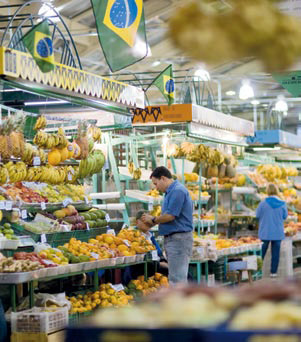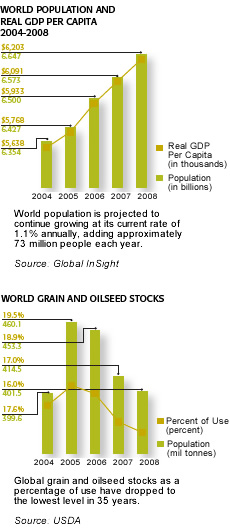
Food demand is growing at a faster rate today than in the past due to steady increases in global population and rapid growth in per capita income – especially in many parts of the developing world.
"The traditional drivers of population and income growth are still the main engines powering grain and oilseed demand. Agriculture today is challenged to discover and develop more productive, efficient and environmentally friendly ways to meet the growing food and fuel demands of a rapidly developing world."
Today, we live in an increasingly populous and prosperous world, one in which accelerating demand for food is a powerful force. During the past five years, demand for the major grain and oilseed crops has grown at a compound annual rate of 2.3%, nearly twice the rate of the previous ten years. An understanding of the dynamics driving this demand is key in order to appreciate how this new era of demand creates both opportunities and challenges for an agricultural industry whose primary purpose is to feed people.

More People, More Prosperity
The first demand dynamic is straightforward – there are more people to feed each year. Today, world population is growing at about 1.1% per year. That may not sound like much, but it means we need to set the dinner table for an additional 73 million people each year. It is the equivalent of adding countries the size of Thailand and Laos to the world every year.
The second demand driver is even more powerful – more people can afford to eat better. Average gross domestic product per capita has increased 2.4% per year during the last five years, up from a rate of 1.4% during the previous 10 years. Most analysts project that per capita GDP will continue to grow at this higher rate for the foreseeable future.
China and India are leading the way. Per capita GDP increased at more than 10% and 7% per year in these two countries during the last five years. To put these rates into context, McKinsey & Company estimates that almost 1.1 billion people will join middleclass income groups in China and India alone between 2005 and 2025. Rising affluence is not limited to Asia. Per capita GDP has increased 3.4% per year during the last five years in Latin America, well above the global average of 2.4% for this period.
The Link Between Prosperity & Protein
As millions of people climb into more affluent income groups, a protein rich diet is one of their first lifestyle improvements. This, in turn, boosts demand because protein rich diets are more grain and oilseed intensive than carbohydrate-based diets. For example, the production of one pound of beef, pork and chicken requires approximately seven, four and two pounds of feed, respectively. As a result, when people incorporate more protein into their diets, it has an exponential effect on grain and oilseed demand.

Biofuels Put Into Context
The increase in global biofuels production no doubt has helped to accelerate global grain and oilseed demand. Although critics blame biofuels for the run-up in agricultural commodity prices and for rising food inflation around the world, the increase in biofuels production is just one of several demand and supply factors that have combined to tighten global grain and oilseed markets during the last two years.
Biofuels today account for a tiny percentage of global grain use and they will continue to account for a small percentage of total use for the foreseeable future, even with large projected increases in production. For example, a recent study estimated that the net amount of grain used for ethanol production accounted for just 3.3% of global use in 2007. And long-term forecasts indicate that net grain used for ethanol will increase to only 4.5% to 5.0% of projected global grain use by 2015. In an energy-craving world, biofuels will remain legitimate and small, but still a significant part of the energy supplies and policies in many countries.
Food, Feed and Fuel Going Forward
This extraordinary agricultural environment is different from past cycles that have resulted from weather-related supply shocks. This cycle is driven, in part, by faster demand growth that we believe is sustainable for the foreseeable future. The good news is that the world is developing and more people are gaining the means to improve their diets, as well as other basic needs such as clothing, housing and transportation. The challenge for many industries is that accelerating demand growth for basic commodities is straining the world's resources.
In the case of food, there is reason for great optimism. Farmers can bring additional land into production in many regions such as Africa, the Americas and the former Soviet Union without jeopardizing the environment. In addition, the adoption of modern technologies coupled with the use of best practices can narrow the wide yield gaps that exist between countries. Mosaic's essential role in the supply side of this story is outlined on the next page.